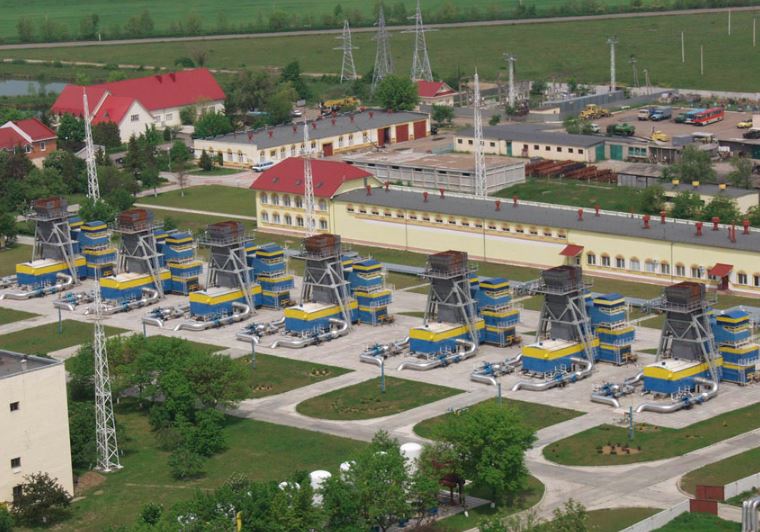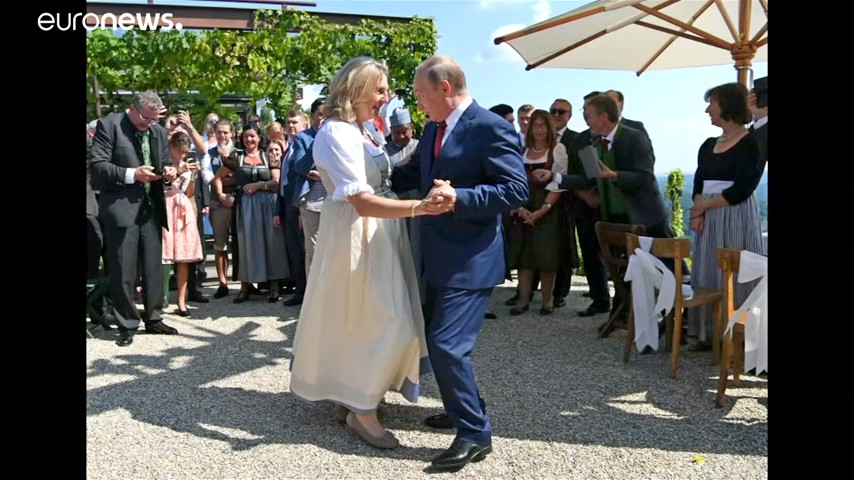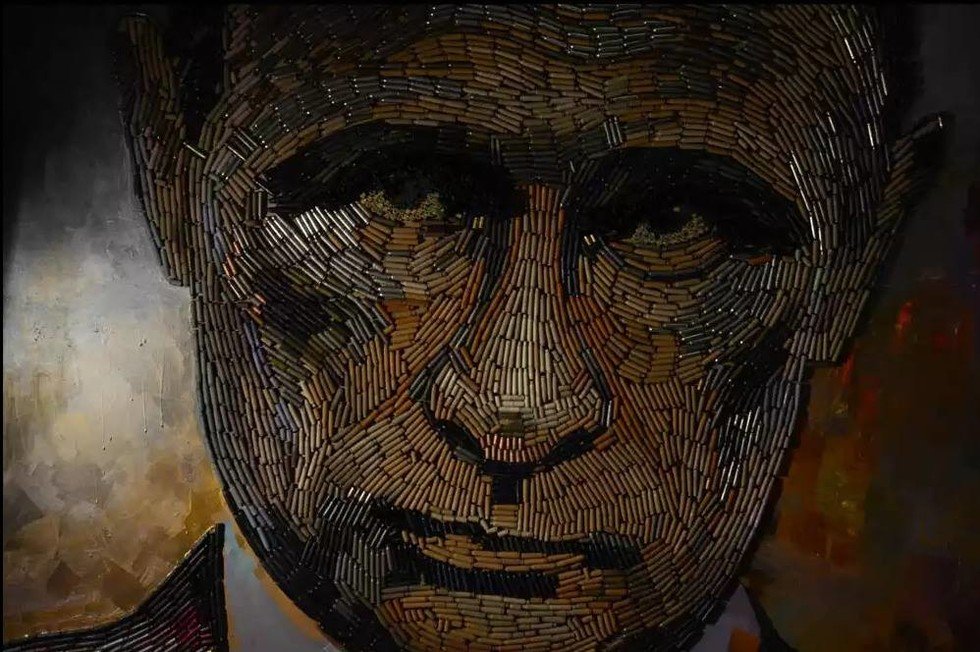However, Russia deliberately shuns this option. In 2021, Russia dropped gas transit volumes through Ukraine thrice, from 186 mn m3/day to the current 109 mn m3/day. But the real volumes of transport are presently smaller than even this decreased ordered (and paid for) capacity, standing at 85.9 mn m3/day, according to the Head of Ukraine’s Gas Transport System Serhiy Makogon.

“If Gazprom returned to transit volumes of December 2020, the EU would start receiving an additional 100 million m3 per day, or almost 3 billion m3 per month. Obviously, increasing gas supplies to the EU is not part of Gazprom’s plans,” Makogon sums up.
The Kremlin justifies its decision by the presumed unreliability of Ukraine’s transport system. But in fact, Ukraine has heavily invested in its modernization, which cannot be said of Russia’s GTS. The only reason for Russia’s decreased gas transit is to blackmailing the EU to make operational the controversial Nord Stream 2 pipeline.
Europe is facing an unprecedented surge in natural gas prices, threatening a large-scale energy crisis. The targeted actions of Gazprom have caused this shortage of natural gas on the eve of winter: the Russian state concern thus puts pressure on Germany and the European Union to obtain a permit to start operation of the Nord Stream-2 gas pipeline as soon as possible.
FIND THE DETAILS HERE:
Obey the Kremlin or pay up: why the EU’s heating bills will skyrocket this winter
And so, amid panic in the European market, when the price of a thousand cubic meters almost soared to an incredible $2,000, Putin held a meeting on “energy sector development.” For two hours, as reported by Kommersant, he “felt like the king of Europe.” The Kremlin has traditionally denied responsibility for the gas crisis.
According to a number of experts, the Russian state concern really did fulfill its contractual obligations to European clients. However, it did so by emptying its gas storage facilities in the EU. And at the same time, despite high demand and high prices, it did not book additional transit through Ukraine.
Russia does not explain why it won’t book additional capacity, writes Bloomberg. However, Amos Hochstein, a senior US State Department adviser for energy security, said it was a political move.
“The reality is there are pipelines with enough capacity through Ukraine to supply Europe. […] Russia has consistently said it has enough gas supply to be able to do so, so if that is true, then they should, and they should do it quickly through Ukraine,” said Hochstein.
According to Mikhail Krutikhin, a Russian economic analyst and oil and gas market specialist, “[Ukraine’s] pipeline capacity is enough to supply gas to two Europes.”
“When some expert starts telling you that Nord Stream 2 is meant for ‘new’ gas for Europe, you can stop listening right away. This expert is corrupt. Nord Stream 2 just circumvents transit from Ukraine at the Kremlin’s whim,” says Krutikhin.
Non-commercial behavior
During the meeting, Putin did mention the possibility of increasing gas supplies through Ukraine’s GTS. But he objected to it, claiming it is unprofitable for Gazprom. Moreover, he alleged that the only reason Ukraine’s transit exists is because of his goodwill, while the Russian state concern is ready to give it up even at the risk of a fine.
This argument about unprofitability is a “blatant lie,” says Lana Zerkal, former Deputy Foreign Minister of Ukraine for European Integration (2014-2019). According to her, the Russian monopolist could be earning over $3 billion extra.
“Refusing this opportunity is another sign of non-commercial behaviour on the part of the monopolist and the use of gas as a geopolitical weapon,” said Zerkal.
Ukraine earmarked 1.5 billion euros for modernizing its GTS

Secondly, Putin continued, Ukraine’s GTS had allegedly “not been reconstructed or repaired for decades, something could burst there at any moment.”
The Center for Strategic Communication asked the Ministry of Energy of Ukraine to provide information on the real condition of the Ukrainian GTS.
“Incidents on the Ukrainian GTS have never led to the interruption of gas supply. It is one of the largest and most extensive gas transmission systems in Europe, and it allows for rapid manoeuvring of natural gas flows. On one of the gas pipelines/routes, the flows can be directed to another, while maintaining the obligations to supply natural gas at a specific exit point,” the Ministry of Energy said.
The Ministry also added that the absence of repairs and reconstructions on the Ukrainian GTS is “complete fiction.” The GTS operator strictly complies with all the necessary regulations, which determine the diagnostic measures and the number of repairs.
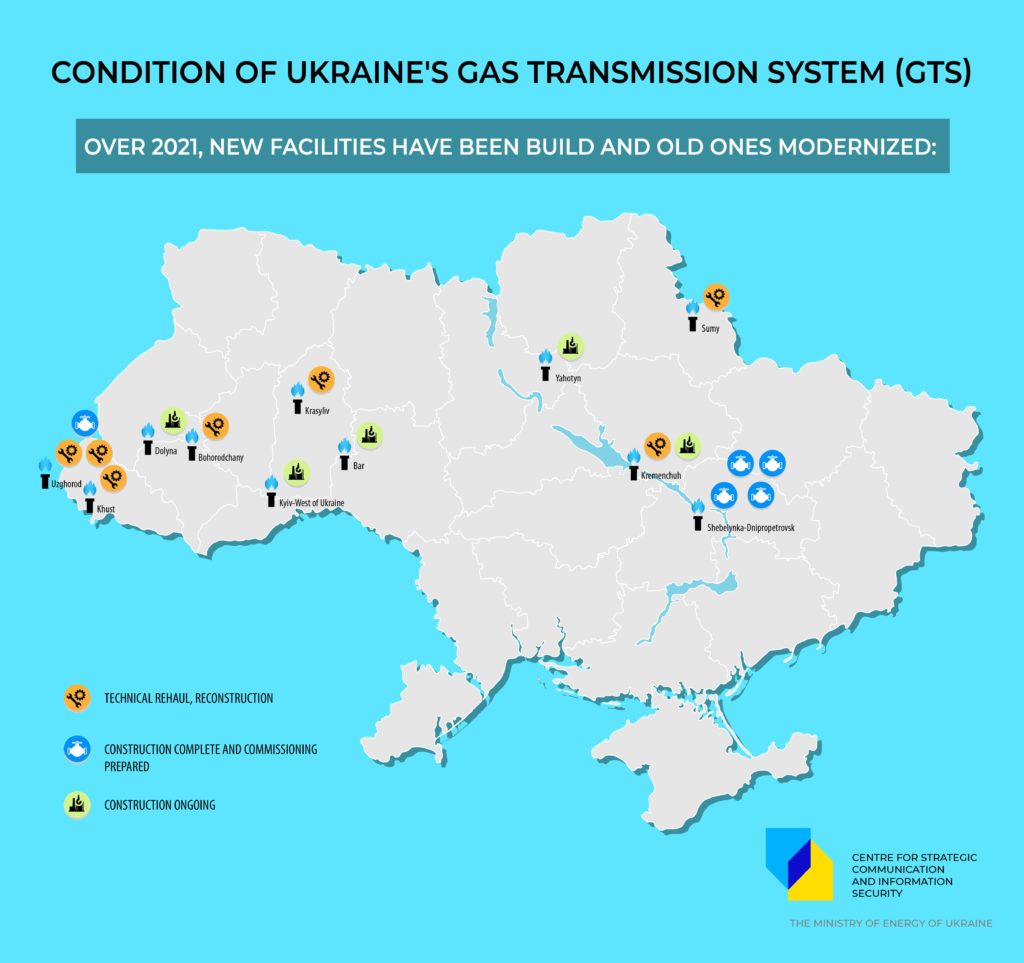
In addition, the Ukrainian GTS is implementing a large-scale modernization program: overhaul, technical re-equipment, reconstruction, construction. During 2021, seven facilities were commissioned, construction was completed and commissioning scheduled for four. Four more are under construction.
Reconstruction of eight compressor stations and almost 200 gas distribution stations is planned.
In just 8 months of this year, Ukraine invested UAH 4.6 billion ($175 million) into capital investments, repairs, maintenance, and diagnostics on its gas transport system.
The approved 10-year GTS Development Plan provides for about 1.5 billion euros of investment in technical upgrades of the gas transmission system.

Seven accidents on Russian GTS in 2021 alone
With such a reliable route for transporting gas to Europe through the territory of Ukraine, Gazprom’s underwater bypass pipelines cannot boast of the same flexibility. And in case of incidents/failures or repairs, their gas supply stops completely.
In addition, the condition of the ground infrastructure of the Russian gas transmission system is by no means better than the Ukrainian GTS. Both the operating time and technical indicators serve as proof for this. Especially problematic are the traditional transit corridors — Urengoy, Progress, Soyuz.
Over 2021, the Russian GTS suffered seven major accidents: the one on the Perm-Gorky-1 trunk pipe, the emergency situation on the Kachkanar branch, accidents on the Soyuz and Orenburg-Novopskov pipelines, fires at the Yubileyniy field, a branch to the Beloretsk gas distribution system, the Central Asia-Center 2 and Urengoy-Center 2 pipelines.
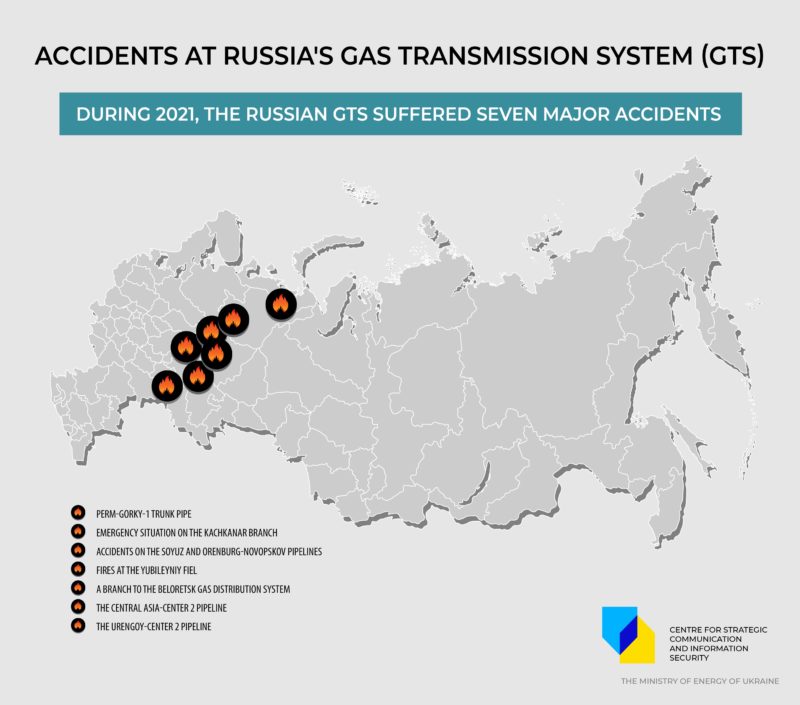
Serhii Makohon, head of Ukraine’s GTS Operator, believes that the Kremlin questions the technical state of the Ukrainian GTS to force the EU to certify Nord Stream 2 ASAP.
“Incident statistics suggest that our Russian colleagues should also increase investments in support of their own GTS. Nord Stream is only a small part of Russia’s GTS that needs daily attention. Therefore, money spent on the excessive Nord Stream 2 could have been spent on upgrading the Russian GTS,” says Makohon.
Just the beginning
Russia’s decision not to transit more gas through Ukraine has undoubtedly exacerbated the crisis in Europe, writes The Atlantic Council. Moscow’s position has sent shock waves across the continent.
But this is just the beginning. If the transit route through Ukraine stops, and Russian gas transit instead passes through Nord Stream and Turkish Stream without clear legal guarantees that these routes will not be used as tools of geopolitical coercion, Europe’s current energy crisis may only be a sign of more trouble to come.
Related:
- US House of Representatives may have just killed Nord Stream 2
- Obey the Kremlin or pay up: why the EU’s heating bills will skyrocket this winter
- Two keys to defeating Nord Stream 2 lie in Poland
- “A second Budapest memorandum”: experts on the US-Germany Nord Stream 2 deal
- Russia’s March-2018 gas war attempt against Ukraine, explained




